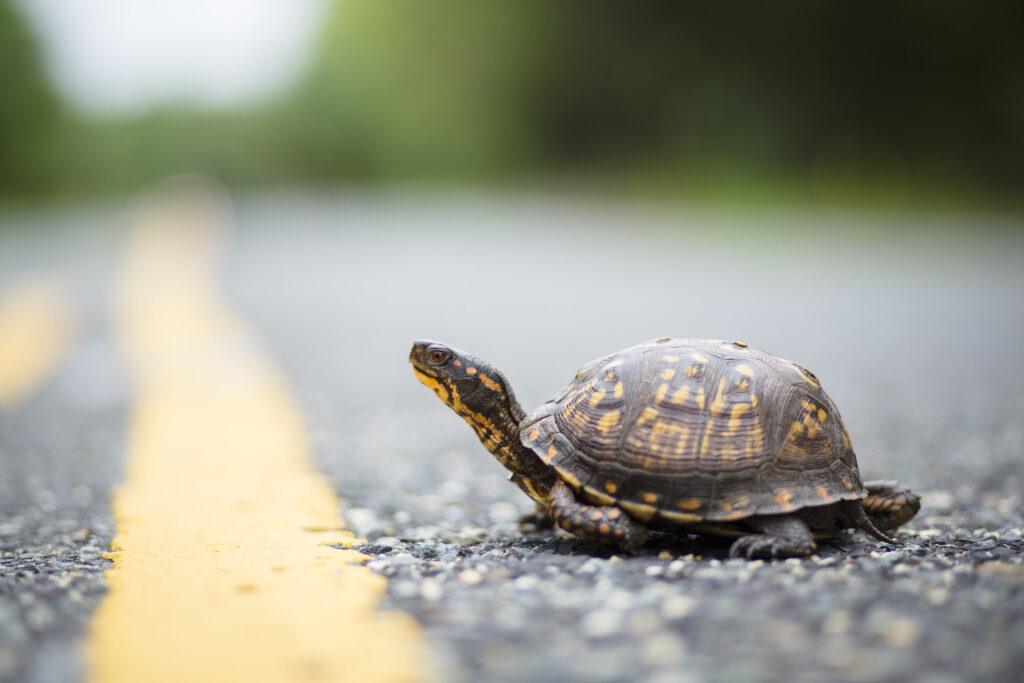We joke, “Why did the turtle cross the road?” But we should be asking, “Why in the world do turtles lie in the middle of the road!?”
It starts with hibernation. Here in temperate Indiana, turtles hibernate during late fall and winter by going into a body of water and burrowing into the mud. Once completely buried, they enter a state called torpor. Their metabolism slows down, they don’t seek out food, and they require less oxygen. They breathe under the mud by absorbing dissolved oxygen in the water through their cloaca—essentially, they breathe through their butts!
In Indiana, ice can remain on a pond’s surface for weeks at a time. Because most of the oxygen that is dissolved in the pond water gets there through direct contact between the water and the atmosphere, no water-to-air contact for extended periods can create problems for animals. Eventually, the oxygen in a frozen pond can get used up.
Brilliantly, some of our native Indiana turtles, including painted turtles and snapping turtles, evolved a way to get around this. When the oxygen in a frozen water body gets used up, they can switch over to a type of breathing that does not require oxygen at all called anaerobic respiration.
Humans can do this too. It’s what happens when we exercise intensely and become short of breath. When our body can no longer take up enough oxygen to maintain our activity level, it starts undergoing a process to convert glucose (simple sugar) into energy without the use of oxygen. This process is called lactic acid fermentation.
When someone is running or doing an intense workout, they may notice their muscles start to burn. This burning is caused by a buildup of lactic acid in the muscles. If too much lactic acid builds up, it can become painful or even dangerous. So how do turtles endure it for weeks at a time?
Turtles’ shells are composed of two things: scutes, which coat the outsides of the shell, and bone, which composes the structure of the shell. Bones are full of calcium. Much like how we eat chalky, calcium-rich antacid tablets when we have heartburn, turtles can use their own built-in calcium stores via their shells to neutralize some of the lactic acid.
This doesn’t neutralize all of it, however. Come springtime, turtles are a mess of sore and burning muscles once they emerge from the mud. This is partially why turtles can be seen basking in the sun on warm spring days. They need their bodies to warm up to get their metabolism back up to speed and flush the lactic acid buildup in their muscles.
If you’ve ever seen what seems like an inordinate number of turtles on a log, you know how prime basking spots are highly sought after and can be a cause for competition. Instead of competing, what better basking spot is there than a black-top road? The black top soaks up the sun’s warmth and helps to warm up a cold turtle from both its belly and its back. Its muscles start to relax and soon the soreness and burning sensation are gone.
This is what is going through a turtle’s mind when it is lying in the middle of the road.
Turtles have been around for hundreds of millions of years. Cars have only been around for a little over a hundred. Turtles don’t understand what cars are and why they’re dangerous. They only understand that their muscles hurt and they need to warm up. This is why, as humans, it is our responsibility to be on the lookout for turtles on the road.
If you see a turtle in the road, safely stop, move them to the other side of the road in the direction they are facing, and carry on. For most turtles, you should always pick them up by the sides of the shell. Be sure to never pick up a turtle by its head or tail, for both could result in the dislocation of its spine and subsequent paralyzation or even death. Always make sure to handle them with the utmost care and be gentle.
Why did the turtle cross the road? To get to the other side. But why did the turtle stay on the road? Because it was sore!
Natalie Grant is the Stewardship Technician for Red-tail Land Conservancy. Through her work in conservation and restoration, she is dedicated to counteracting negative human impacts on native ecosystems.




